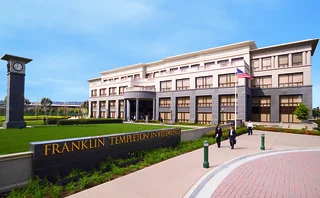Max Bowie: Technology Is Getting Smaller, and So Is Sifma

Plenty of attendees at this year’s Sifma Tech Expo were ready to pronounce the event dead—I wouldn’t say that, though I would say it’s in intensive care—and just as many ready to expose its killers and administer their own prescribed treatment. But what ails the Sifma show isn’t a bug that can be treated with a sharp dose of antibiotics and bed rest—it’s more like multiple viruses attacking Sifma’s central nervous system all at once.
And like a virus, the wounds aren’t self-inflicted, but are contracted simply through proximity to others with the sickness—namely, the global financial services industry. The economy is one of the biggest factors in the lower number of exhibitors and attendees. On one hand, the cost of exhibiting isn’t prohibitive, although the tough economy makes companies more conscious of all spending, while the effect of budget and job cuts at banks means consumers can’t tear themselves away as they used to.
Second, the large vendors that supported Sifma in the past and made it the place to be seen have largely abandoned the show—some even holding their own offsite events in recent years to cannibalize Sifma’s attendee list—while some smaller ones realized they could avoid the cost of exhibiting by courting potential clients in the bars of the same venue. In addition, there are now more industry events competing for marketing budgets against Sifma, many of which didn’t exist 10—or even five—years ago, such as those run by industry associations and media companies, including Waters parent Incisive Media’s own events. And while everyone had their own suggestion of how to perk up next year’s show, there was no Dr. House present to cure every symptom with a wave of his magic walking stick to keep the show alive another year.
Positive Notes
Although the smaller show did allow relative newcomers—like Digital Look with its Stingray application; or Kaazing, which created a mock-up, web-based data display for the show; and Narrative Science, which creates news stories and commentary from raw data—to gain a higher profile, other hot technology areas didn’t capitalize on the exodus of “traditional” vendors. For example, mobile is an incredibly hot space right now, so it was good to see Sprint take a booth at the show, despite the bring-your-own-device movement making corporate rollouts of mobile devices less necessary. But where were all the developers of financial apps for smartphones and tablets?
For example, Thomson Reuters could have shown off its recent acquisition of Apsmart, a London-based mobile application developer founded by Rahul Powar, former technologist for music-identifying app Shazam.
But are apps really suitable subject matter for Sifma? Absolutely. According to Bob Schukai, global head of mobile technology at Thomson Reuters, mobile technologies are more important than ever in the enterprise space.
“We do a lot of our own development work already, but there is an insatiable appetite for this in the financial and legal industries and we were trying to figure out how to get scale, either through hires or by acquiring a known team with a pedigree,” Schukai says, comparing Powar’s background at Shazam to enterprise apps that need to access huge databases of information on the back-end, but which display that information through a light, mobile interface. In addition, as vendors move to an “app store”-type model, the ability to build and integrate apps will become ever-more important.
And while the vendor is already making efforts to make its legal content more available via its WestlawNext iPad app and ProView legal e-reader app, the Apsmart team will work across all Thomson Reuters’ business lines, especially for its governance, risk and compliance unit, where demand is “exploding,” Schukai says.
If this area is exploding, then so should demand from these companies to gain access to Sifma’s membership and attendee list. It may well be Sifma’s ability to attract cool new companies like Apsmart, Kaazing and Narrative Science—or social media aggregator Gnip, which held its own conference in Boulder the same week—rather than “traditional vendors” that ensures the show’s ability to evolve and grow.
Only users who have a paid subscription or are part of a corporate subscription are able to print or copy content.
To access these options, along with all other subscription benefits, please contact info@waterstechnology.com or view our subscription options here: https://subscriptions.waterstechnology.com/subscribe
You are currently unable to print this content. Please contact info@waterstechnology.com to find out more.
You are currently unable to copy this content. Please contact info@waterstechnology.com to find out more.
Copyright Infopro Digital Limited. All rights reserved.
As outlined in our terms and conditions, https://www.infopro-digital.com/terms-and-conditions/subscriptions/ (point 2.4), printing is limited to a single copy.
If you would like to purchase additional rights please email info@waterstechnology.com
Copyright Infopro Digital Limited. All rights reserved.
You may share this content using our article tools. As outlined in our terms and conditions, https://www.infopro-digital.com/terms-and-conditions/subscriptions/ (clause 2.4), an Authorised User may only make one copy of the materials for their own personal use. You must also comply with the restrictions in clause 2.5.
If you would like to purchase additional rights please email info@waterstechnology.com
More on Emerging Technologies
DTCC revamps tech abilities following global reporting overhaul
The Repository & Derivatives Services unit is implementing new technologies to help its clients keep up with changing reg reporting regimes.
Waters Wavelength Ep. 336: Tokenization mania
This week, Tony and Shen talk about the topic that everyone seems to be talking about...tokenization.
Finos’ orchestration platform, digital asset hype, OMS news and more
The Waters Cooler: ISI’s sovereign debt footprint, Bolsa Mexicana’s modernization efforts, Franklin Templeton’s DeFi play, and more.
BlackRock and DRW execs bullish on tokenization potential
DRW’s Don Wilson expects every instrument to be traded on-chain in five years’ time.
Barclays carefully studying stablecoins
CEO CS Venkatakrishnan called the class of digital assets “broad and fascinating,” but urged peers to consider how it fits into the current banking deposit framework.
How an asset manager employs analytics to evaluate performance
Channing Capital, an institutional investment firm managing nearly $5 billion in assets, uses Aapryl to analyze its performance.
Nasdaq looks to ramp up tokenized securities efforts
Nasdaq CEO Adena Friedman wants to see tokenized securities come to the US markets “in a staged process.”
Franklin Templeton’s great DeFi migration
TradFi’s money and DeFi’s tech will inevitably combine, says the asset manager’s futurist-in-residence.








